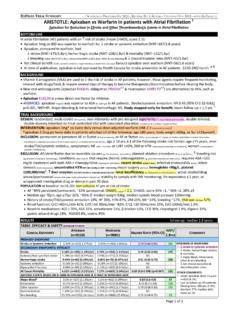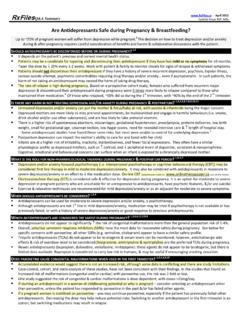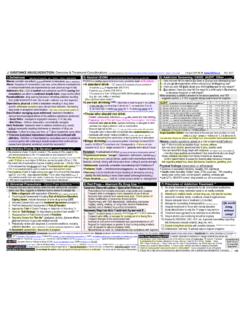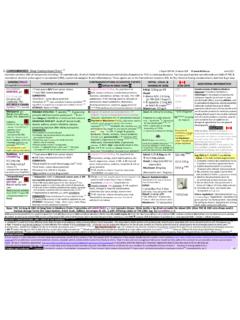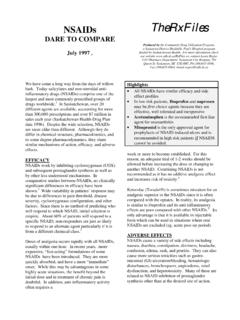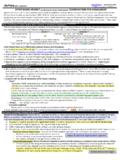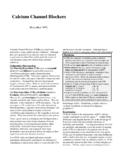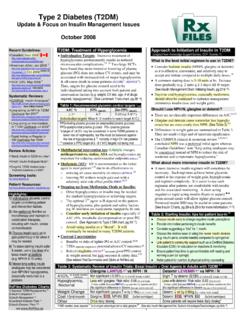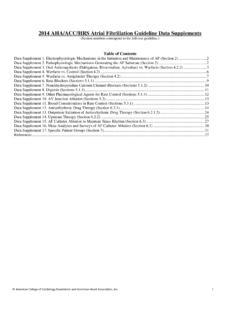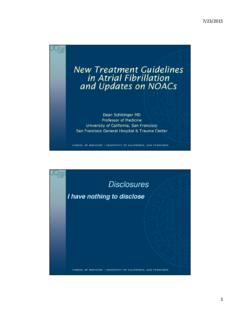Transcription of RXFILES TRIAL SUMMARY O PREPARED IN EVISED BY L KOSAR ...
1 RXFILES TRIAL SUMMARY ORIGINALLY PREPARED BY: M JIN, REVISED BY: L KOSAR UPDATED DECEMBER 2012 Page 1 of 4 rocket AF: Rivaroxaban vs Warfarin in patients with Atrial fibrillation 1 Rivaroxaban Once daily oral direct factor Xa inhibition Compared with vitamin K antagonism for prevention of stroke and Embolism TRIAL in AF BOTTOM LINE In atrial fibrillation (AF) patients with an risk of stroke (mean CHADS2 score ), rivaroxaban 20mg po daily: Was non inferior ( no worse than) to warfarin for stroke or systemic embolism Had less hemorrhagic strokes, systemic embolism & bleeding (critical, fatal & intracranial) versus warfarin Had more drops in hemoglobin 20 g/L, tranfusions, gastrointestinal bleeding, epistaxis & hematuria versus warfarin At time of publication, rivaroxaban for AF is approximately $100/month; 15mg, 20mg tablets.
2 A Fib, Warfarin + monitoring ~$35/month. BACKGROUND Vitamin K antagonists (VKA) are used to the risk of stroke in AF patients; however, these agents require frequent monitoring, interact with drugs/food, & require several days of therapy to become therapeutic/discontinuation before clearing the body. New oral anticoagulants (apixaban ELIQUIS,2,3 dabigatran PRADAX 4,5 & rivaroxaban XARELTO) are alternatives to VKA, such as warfarin. Rivaroxaban XARELTO is a new oral direct factor Xa inhibitor. rocket AF is the first Phase III study assessing the use of rivaroxaban for stroke prevention in AF patients. TRIAL BACKGROUND 6 DESIGN: randomized, multi centre 45 countries, double blinded, double dummy controlled TRIAL with concealed allocation; non inferiority with pre designed superiority, intention to treat & per protocol analysis. Funded by Johnson & Johnson and Bayer.
3 INTERVENTION: rivaroxaban 20mg* po daily vs dose adjusted warfarin (INR 2 3 measured 1 month) * rivaroxaban 15mg po daily in patients with CrCl 30 49 mL/min see page 2 for subgroup analysis INCLUSION: persistent/paroxysmal AF on 2 episodes 1 documented on ECG within 30 days of enrolment; age 18 yrs; risk of future stroke: history of stroke/TIA or systemic embolism OR 2 of the following: HF or LVEF 35%, HTN (on BP meds 6 months before or SBP>140 mmHg or DBP >90 mmHg), age 75 yr, or DM ( CHADS2 score of 2). Only 10% could have a CHADS2 score of 2, with the remainder having a score of 3 or prior stroke, TIA or systemic embolism. EXCLUSION: Cardiac related conditions AF due to reversible disorders, active endocarditis, mitral stenosis, presence of atrial myxoma or LV thrombus, planned cardioversion, prosthetic heart valve, BP 180/100 mmHg; Hemorrhage risk related criteria active internal bleeding, hx of major surgical procedure or trauma within 30 days, GI bleed within 6 months, hx of intracranial/intraocular/spinal/atraumat ic intraarticular bleeding, chronic hemorrhagic disorder, known intracranial neoplasm, arteriovenous malformation, or aneurysm, planned invasive procedure with potential for uncontrolled bleeding, including major surgery; anemia Hgb <100g/L; any stroke within 14 days (severe within 90 days) or TIA within 3 days; indication for anticoagulant therapy for a condition other than AF ( VTE); tx with ASA>100mg/d, ASA/thienopyridine or IV antiplatelets within 5 days.
4 Fibrinolytics within 10 days; anticipated need for long term tx with NSAID; systemic treatment with a strong inhibitor/inducer of CYP P450 3A4 within 4 days or planned treatment during the study; pregnancy/breastfeeding; HIV; CrCl<30mL/min; liver disease or ALT>3x ULN. POPULATION at baseline: n=14,264 non valvular AF patients at risk of stroke AF ~81% persistent, ~ paroxysmal, newly diagnosed/onset; CHADS2 mean = , median=3, CHADS2 score ~13% =2, 43% =3, 29% =4, 13% =5, rivaroxaban vs warfarin = 6 (p< for CHADS2 score of 6). ~60% ; median age 73yrs 25% 78yrs, BMI 28 kg/m2, BP 130/80 mmHg, CrCl 67mL/min History of stroke/TIA 55%, HF 63%, HTN 91%, DM 40%, MI 17% Baseline medications: blocker ~65%, diuretics 60%, ACE I 55%, statins 43%, digoxin 39%, ASA 38%. Previous use of vitamin K antagonist 62%. RESULTS median follow up: per protocol (PP) & safety population = 590 days, intention to treat (ITT) = 707 days TABLE: EFFICACY & SAFETY NON INFERIOR DATA SUPERIORITY DATA RIVAROXABAN WARFARIN HAZARD RATIO (95% CI) NNT/NNH PRIMARY ENDPOINTS PER PROTOCOL (n=6958) ITT (n=7081) PER PROTOCOL(n=7004) ITT (n=7090) PER PROTOCOL ITT PP/ ITT/ Comments Stroke or Systemic Embolism {n=188} {n=269} {n=241} {n=306} ( ) ( ) 135 SECONDARY ENDPOINTS RIVAROXABAN (n=7061) WARFARIN (n=7082) HAZARD RATIO (95% CI) NNT/NNH EFFICACY.
5 Based on safety population, rivaroxaban n=7061 vs warfarin n=7082 excluded violating site & those who did not receive a dose Stroke {n=184} ( ) {n=221} ( ) NS Hemorrhagic Stroke {n=29} ( ) {n=50} ( ) ( ) 333 Systemic Embolism {n=5} ( ) {n=22} ( ) ( ) 417 Myocardial Infarction {n=101} ( ) {n=126} ( ) NS All Cause Mortality {n=208} ( ) {n=250} ( ) NS BLEEDING: Based on safety population, rivaroxaban n=7111 vs warfarin n=7082 excluded those who did not receive a dose Major Bleed* {n=395} ( ) {n=386} ( ) NS Hemoglobin 20g/L {n=305} ( ) {n=254} ( ) ( ) 143 Transfusion {n=183} ( ) {n=149} ( ) ( ) 200 Critical Bleeding {n=91} ( ) {n=133} ( ) ( ) 167 Fatal Bleeding {n=27} ( ) {n=55} ( ) ( ) 250 Intracranial bleed {n=55} ( ) {n=84} ( ) ( ) 250 Gastrointestinal Bleed {n=224} {n=154} P< 100 Epistaxis {n=721} {n=609} P< 67 Hematuria {n=296} {n=242} P< 125 Discontinuation Rates RIVAROXABAN VS WARFARIN: - Non inferior ( no worse than) to warfarin for stroke or systemic embolism.
6 - hemorrhagic stroke, systemic embolism & bleeding (critical, fatal & intracranial). - drop of hemoglobin 20g/L, transfusion, GI bleed, epistaxis & hematuria. WARFARIN VS RIVAROXABAN: - concurrent ASA use: warfarin ( ) vs rivaroxaban ( ) - baseline CHADS2 score of 6: warfarin ( ) vs rivaroxaban ( ), p< - Warfarin TTR= mean 55%, median 58%. North American sites: 64%.7 OTHER COMMENTS: - Lost to follow up: 32 - 93 patients excluded (50 rivaroxaban & 43 warfarin) from all efficacy analyses before unblinding because of violations in Good Clinical Practice. - Subgroup analyses: NS * Major Bleed = Hemoglobin 20g/L, transfused 2units, or symptomatic bleeding critical area or organ (intracranial, spinal, ocular, pericardial, articular, retroperitoneal, or intramuscular with compartment syndrome), fatal outcome or permanent disability. Gastrointes nal Bleed = upper, lower, rectal gastrointestinal bleeding RXFILES TRIAL SUMMARY ORIGINALLY PREPARED BY: M JIN, REVISED BY: L KOSAR UPDATED DECEMBER 2012 Page 2 of 4 PUBLISHED SUBGROUP ANALYSES Note: subgroup analyses are not powered to detect a conclusive difference between treatments groups; however, the following subgroup analyses were similar to the overall TRIAL results with the entire patient population.
7 1) Pre Designed Subgroup Analysis of rocket AF Patients with Moderate Renal Impairment (=CrCl 30 49 mL/min at baseline)8 Background: patients with CrCl 30 49 mL/min have a 25 30% rivaroxaban serum concentration 25% in rivaroxaban =15mg N=2950 ( of rocket AF patient population), rivaroxaban 15mg po daily (n=1474) vs dose adjusted warfarin (INR 2 3, n=1476) Population: compared to the rocket AF patients with CrCl 50 mL/min, patients with a CrCl 30 49 mL/min: - age (median 79 years), CHADS2 score (mean 1), history of HF ~66%, PAD ~ & MI ~19% - 45%, BMI (median 25 kg/m2), history of stroke/TIA ~50% & DM ~32% Compared to the rocket AF patients with CrCl 50 mL/min, patients with a CrCl 30 49 mL/min had an risk of stroke & systemic embolism (primary endpoint) & risk of bleeding. Rivaroxaban 15mg po daily vs warfarin had consistent results when compared to patients with preserved renal function.
8 2) Pre Designed Subgroup Analysis of rocket AF Patients with Previous Stroke or TIA9 N=7468 (52% of rocket AF patient population), previous stroke (n=4907) or TIA (n=2561) Median time from previous stroke or TIA to randomization was 551 days (interquartile range 126 1702 days) Rivaroxaban (n=3754) versus warfarin (n=3714) Population: compared to rocket AF patients without a history of stroke/TIA, patients with a history of stroke/TIA (p< ): - CrCl (median 69 mL/min), CHADS2 score (median 4), previous ASA (38%) or vitamin K antagonist (59%) use - age (median 71 years), BMI (median kg/m2), persistent AF (80%), HTN 85%, HF 51%, DM 25%, MI 15%, PAD 5%, COPD 9% Regardless of study group, patients with a history of stroke/TIA had risk of stroke & systemic embolism (primary endpoint) & risk of major bleeding (compared to rocket AF patients without a history of stroke/TIA): - Stroke & systemic embolism: without history of stroke/TIA vs with a history of stroke/TIA , HR (95% CI ), p< - Major bleeding: without history of stroke/TIA versus with a history of stroke/TIA , HR (95% CI ), p= The comparison of rivaroxaban versus warfarin was similar, regardless of whether the anticoagulants were used as primary or secondary stroke prevention.
9 STRENGTHS, LIMITATIONS, & UNCERTAINTIES STRENGTHS: Important clinical endpoints ( stroke & bleed) Double blind, double dummy with sham INRs Moderate to high risk of stroke (mean CHADS2 score = ) Used both per protocol & intention to treat analysis Similar discontinuation rates in both groups (rivaroxaban versus warfarin ) Only 32 patients lost to follow up ( ) LIMITATIONS: Warfarin was within therapeutic range only 55% North American sites 64% of the study period ACTIVE W , ARISTOTLE 66%, RELY 64% Short study duration One site violated Good Clinical Practice ~ 35% of patients in each arm of the TRIAL were on concomitant aspirin treatment UNCERTAINITIES: Drug not yet studied in patients with CrCL<30 mL/min or in liver disease Drug interactions? stroke after rivaroxaban stopped 28 days later No antidote for reversing bleeding with rivaroxaban Lack long term follow up & real world experience with rivaroxaban RELATED STUDIES J rocket AF10 Japan was not included in the original rocket AF TRIAL because: - Pharmacokinetic data: Cmax & area under the curve for rivaroxaban 15mg po daily in Japanese patients rivaroxaban 20mg po daily in Caucasians.
10 - Japanese clinical practice guidelines recommend a target INR of in patients 70 years of age. N=1280; randomized, double blind, double dummy, multicentre 167 sites non inferiority TRIAL in Japan. Intervention: rivaroxaban 15mg* po daily versus dose adjusted warfarin (INR 2 3 in patients <70 years of age & INR in patients 70 years old). *rivaroxaban 10mg po daily in patients with CrCl 30 49 mL/min 22% of the patient population Safety: rivaroxaban was non inferior to warfarin for the composite of major & non major bleeding; individual composite endpoints not statistically significant when separated. Differences in location of bleeds were not tested for statistical significance. Efficacy: not powered for efficacy stroke & systemic embolism was NS (p= ). Overall, the J rocket AF study results were similar to the global rocket AF study.
